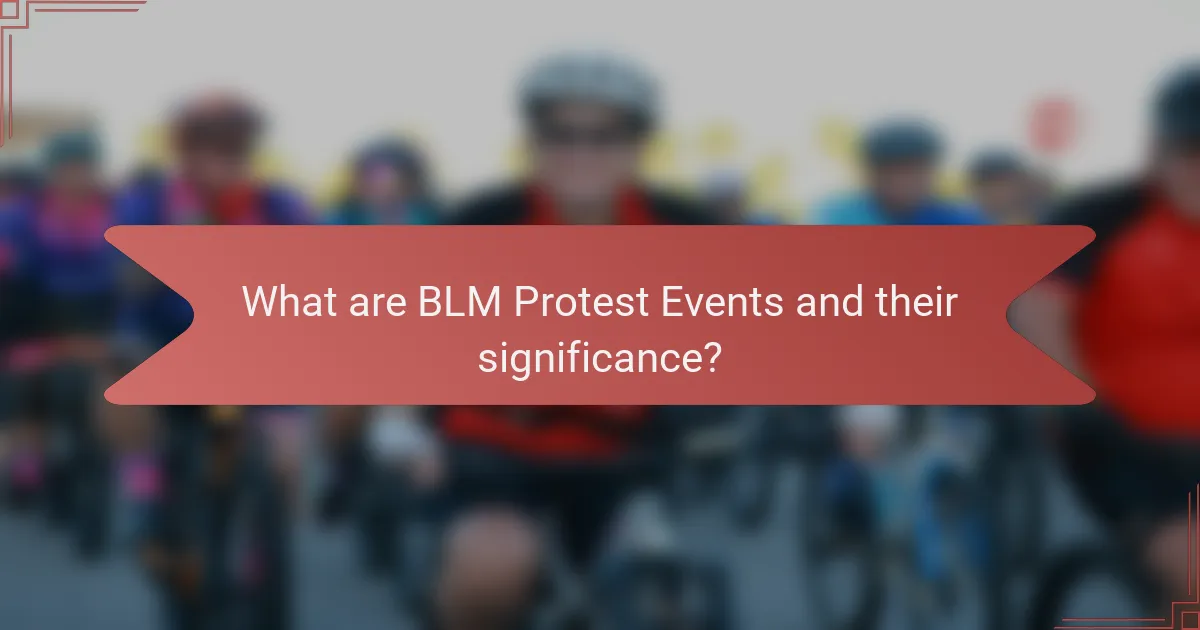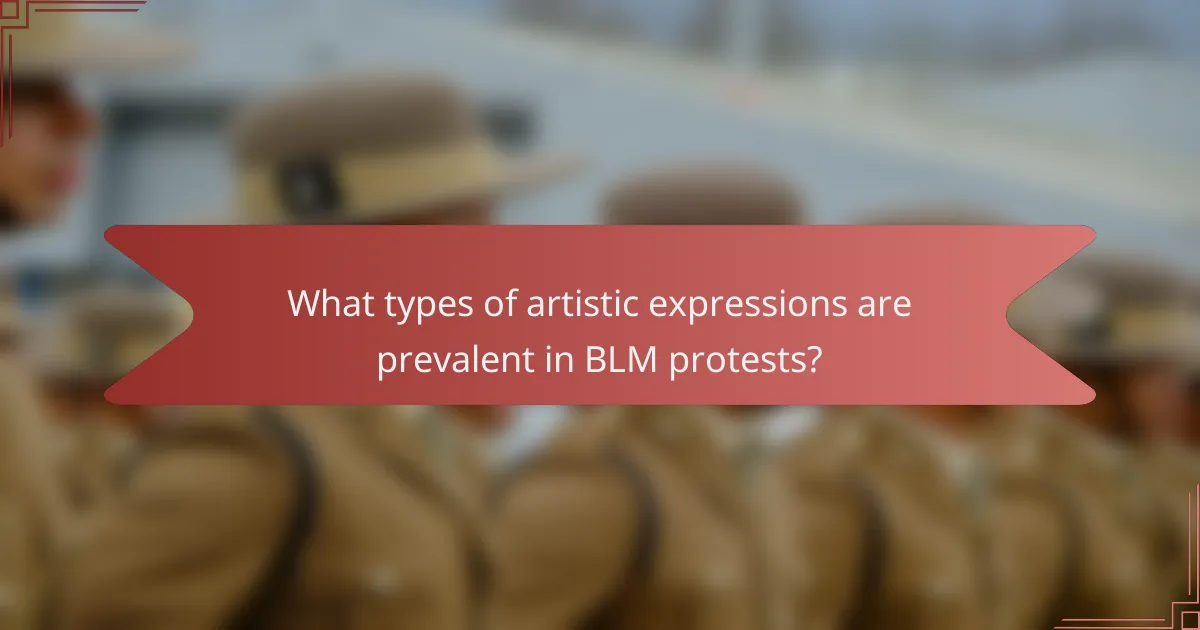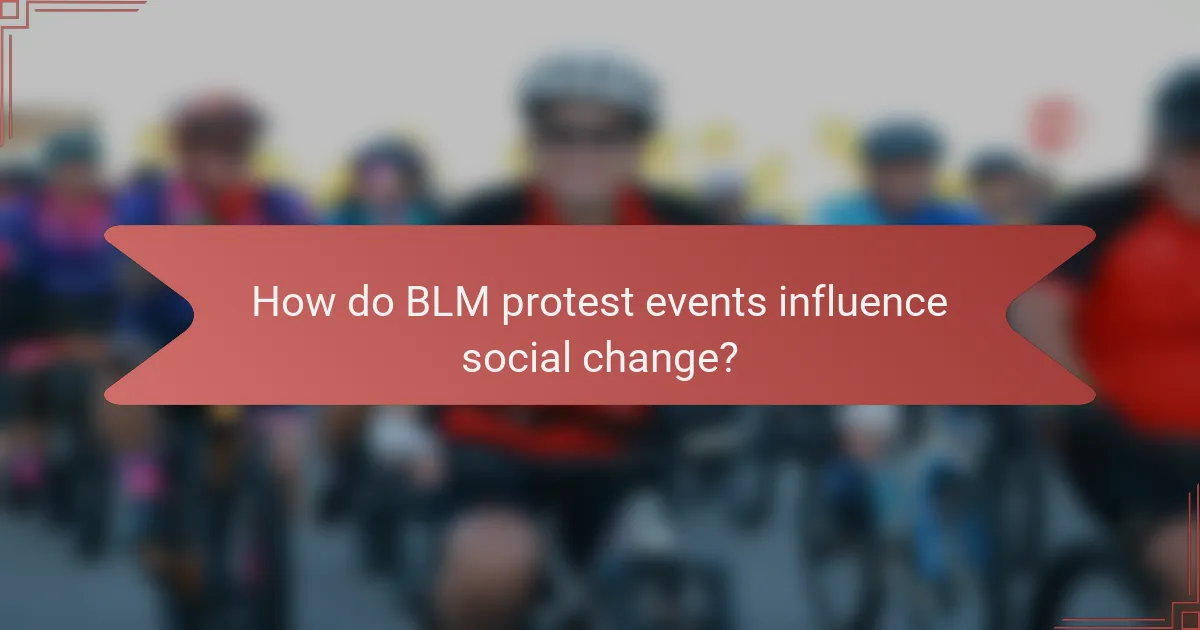
What are BLM Protest Events and their significance?
BLM protest events are organized demonstrations advocating for racial justice and equality, specifically addressing systemic racism and police brutality against Black individuals. These events have gained global attention, particularly following the death of George Floyd in 2020. The significance of BLM protest events lies in their ability to mobilize communities and raise awareness about social injustices. They serve as platforms for artistic expression, where participants use music, visual art, and performance to convey messages of resistance and solidarity. Research indicates that such protests can influence public opinion and policy changes related to civil rights. The events also foster a sense of community and empowerment among participants, reinforcing the collective demand for equity and justice.
How do art and expression play a role in BLM protests?
Art and expression are vital in BLM protests as they convey messages of resistance and solidarity. Visual art, such as murals and graffiti, often features powerful imagery and slogans that encapsulate the movement’s core values. These artistic expressions serve as a means to communicate the experiences of marginalized communities. Performance art, music, and spoken word also play crucial roles in engaging and mobilizing participants. They create an emotional connection and foster a sense of community among demonstrators. Studies show that art can amplify social movements by attracting media attention and public interest. For instance, the mural of George Floyd in Minneapolis became a symbol of the BLM movement, drawing visitors and sparking conversations about racial justice. Overall, art and expression are essential tools for advocacy and awareness in BLM protests.
What forms of art are commonly seen in BLM demonstrations?
Forms of art commonly seen in BLM demonstrations include murals, banners, and signs. Murals often depict powerful imagery and messages related to racial justice. Banners are frequently used to convey slogans and demands for change. Signs created by participants often feature personal messages and artistic expressions. Street performances, including spoken word and music, also play a role in these demonstrations. Visual art serves to unify participants and communicate their collective message. These artistic expressions enhance the emotional impact of the protests. They reflect the cultural significance of the movement and engage a wider audience.
How does art enhance the message of BLM protests?
Art enhances the message of BLM protests by visually conveying the urgency and emotion of the movement. It serves as a powerful tool for communication, transcending language barriers. Murals, signs, and performances encapsulate the struggle against racial injustice. These artistic expressions often reflect personal stories and community experiences. For instance, the mural of George Floyd in Minneapolis became a symbol of resistance. Art fosters a sense of unity among protesters, bringing diverse voices together. It also captures media attention, amplifying the movement’s reach. Statistics show that visual art increases engagement on social media platforms, spreading awareness further.
Why is community involvement important in BLM protest events?
Community involvement is crucial in BLM protest events because it fosters solidarity and collective action. When individuals from diverse backgrounds unite, they amplify the message of racial equality. This unity can attract media attention, raising awareness about the movement’s goals. Community participation also encourages dialogue about systemic racism and social justice. Engaged communities can mobilize resources, such as food, supplies, and volunteers for events. Studies show that grassroots movements are more effective when they involve local communities. A notable example is the 2020 protests, where widespread community engagement led to significant policy discussions. Overall, community involvement strengthens the impact and reach of BLM protests.
How do local artists contribute to the expression at these events?
Local artists enhance expression at BLM protest events through their creative works. They create murals, posters, and performances that reflect the movement’s messages. These artworks often convey themes of justice, equality, and solidarity. Local artists also engage the community by inviting participation in collaborative art projects. Their contributions foster a sense of unity and shared purpose among demonstrators. Additionally, art at these events serves as a powerful visual language that communicates the struggles faced by marginalized communities. Historical examples include the murals created during the 2020 protests, which captured public attention and sparked dialogue. Overall, local artists play a crucial role in amplifying voices and messages within the BLM movement.
What are the benefits of community engagement in protest art?
Community engagement in protest art fosters solidarity and amplifies voices. It brings together individuals with shared experiences and goals. This collective effort enhances the emotional impact of the art. Research indicates that art created through community participation resonates more deeply with audiences. Engaged communities can effectively convey their messages and demands through visual expression. In the context of BLM protests, this engagement helps to address systemic injustices. It creates a sense of ownership and pride among participants. The collaborative process also encourages dialogue and reflection on social issues.

What types of artistic expressions are prevalent in BLM protests?
Artistic expressions prevalent in BLM protests include murals, banners, and performance art. Murals often depict powerful imagery related to racial justice and community empowerment. Banners are frequently used to convey messages and slogans that resonate with the movement’s goals. Performance art, such as spoken word poetry and dance, serves to engage participants and evoke emotional responses. Street art, including graffiti, is also common, providing a platform for spontaneous expression. These forms of art not only beautify protest spaces but also communicate the urgency of the movement’s message. Many artists collaborate with community members to create pieces that reflect local experiences and histories. This artistic engagement fosters a sense of unity and shared purpose among protesters.
How does visual art manifest in BLM demonstrations?
Visual art manifests in BLM demonstrations through murals, signs, and performance art. Murals often depict powerful imagery related to racial justice and community empowerment. These large-scale artworks serve as a visual representation of the movement’s goals. Signs created by protesters frequently feature slogans and messages that convey demands for justice and equality. Performance art at demonstrations can include spoken word, music, and dance, which engage participants emotionally. The art created during these events fosters a sense of unity and collective identity among participants. This visual expression not only communicates messages but also honors victims of racial violence. Studies show that art in protests can enhance visibility and impact of social movements.
What role do murals and graffiti play in conveying protest messages?
Murals and graffiti serve as powerful tools for conveying protest messages. They visually communicate dissent and social issues to a broad audience. These forms of art can capture attention quickly in public spaces. Murals often depict the struggles and aspirations of marginalized communities. Graffiti can express urgency and raw emotion in a way that resonates deeply. Historical examples include the Berlin Wall murals and the street art during the Arab Spring. In the context of BLM protests, murals have emerged as memorials for victims of police violence. They create a lasting impact and foster community dialogue around systemic racism.
How do banners and placards serve as a form of artistic expression?
Banners and placards serve as a form of artistic expression by conveying messages visually and symbolically. They often incorporate vibrant colors, bold typography, and creative imagery. This artistic approach captures attention and evokes emotional responses. Historical examples include the use of banners in civil rights movements. The design elements communicate solidarity and urgency. Additionally, they reflect cultural identity and personal stories. Research shows that visual art can enhance message retention during protests. This demonstrates the powerful role of art in activism.
In what ways is performance art utilized during BLM events?
Performance art is utilized during BLM events as a means of expression and activism. Artists engage audiences through live performances that convey messages about racial injustice. These performances often include spoken word, dance, and theater. They aim to evoke emotional responses and provoke dialogue. Performance art serves as a powerful tool for storytelling and sharing personal experiences. It highlights the urgency of the Black Lives Matter movement. Specific examples include organized performances at protests and public spaces. These events often attract media attention, amplifying the message of the movement.
What are the key elements of performance art in protest settings?
Key elements of performance art in protest settings include embodiment, audience engagement, and political messaging. Embodiment refers to the physical representation of ideas and emotions through the artist’s body. This can create a visceral experience for viewers. Audience engagement involves direct interaction or participation, making the audience part of the performance. This can amplify the emotional impact of the protest. Political messaging is critical; it conveys specific social or political issues. Performance art often uses symbolism and metaphor to communicate these messages effectively. Historical examples include the 2014 “Black Lives Matter” movement, where artists used their bodies to reflect societal injustices. Such performances can provoke thought and inspire action among audiences.
How does performance art engage the audience in the protest narrative?
Performance art engages the audience in the protest narrative by creating immersive experiences that evoke emotional responses. This form of art often incorporates elements of storytelling, movement, and visual aesthetics. It invites spectators to witness the struggles and aspirations of marginalized communities. For instance, during BLM protests, artists use their bodies and voices to symbolize resistance and resilience. This direct engagement fosters a sense of connection between the performers and the audience. Research shows that performance art can lead to increased empathy and understanding among viewers. By participating in these experiences, audiences are encouraged to reflect on social injustices. This reflective process can motivate individuals to take action in support of the protest’s goals.

How do BLM protest events influence social change?
BLM protest events influence social change by raising awareness of racial injustice. These events mobilize communities and create a platform for marginalized voices. They often lead to policy discussions and legislative changes. For instance, the protests following George Floyd’s death prompted police reform debates across multiple states. Research shows that sustained protests can shift public opinion on racial issues. A study by the Pew Research Center indicated that support for the Black Lives Matter movement increased significantly after major protests. Furthermore, these events foster solidarity among diverse groups, uniting individuals for a common cause. Ultimately, BLM protests serve as catalysts for broader societal transformation.
What impact does art have on public perception of BLM movements?
Art significantly influences public perception of BLM movements. Artistic expressions, such as murals and performances, communicate the movement’s messages effectively. They create emotional connections, fostering empathy among viewers. Public art can challenge stereotypes and provoke discussions about racial injustice. Studies show that visual representations can increase awareness and understanding of social issues. For instance, the mural “Black Lives Matter” painted in Washington, D.C., garnered national attention and support. Art also serves as a powerful tool for mobilization, encouraging community engagement. Overall, art shapes narratives and can shift public opinion regarding the BLM movement.
How can artistic expressions shift societal attitudes towards racial justice?
Artistic expressions can shift societal attitudes towards racial justice by fostering empathy and raising awareness. They communicate complex emotions and narratives that resonate with diverse audiences. For example, murals and performances during BLM protests often depict the struggles and experiences of marginalized communities. This visual storytelling can challenge stereotypes and provoke critical conversations. Research shows that art can influence public perception by engaging viewers emotionally. A study by the National Endowment for the Arts indicates that art can enhance understanding of social issues. Additionally, artistic expressions can unite communities, creating a shared sense of purpose. By inspiring collective action, they contribute to the momentum for change in societal attitudes.
What evidence exists to show the effectiveness of art in protests?
Art in protests effectively amplifies messages and mobilizes communities. Evidence includes various studies and historical examples. For instance, the use of murals during the Black Lives Matter protests increased awareness and solidarity. A study by the University of California found that visual art in protests significantly enhanced media coverage. Additionally, the “Art of Protest” report by the Center for Cultural Power highlights how art engages diverse audiences. Art also fosters emotional connections, making messages more relatable. These factors collectively demonstrate art’s crucial role in enhancing the impact of protests.
How can individuals get involved in supporting art at BLM protests?
Individuals can support art at BLM protests by creating and sharing artwork that reflects the movement’s messages. They can also participate in mural projects or community art installations. Collaborating with local artists can amplify their impact. Volunteering at art workshops during protests helps foster creativity. Providing materials like paint, brushes, and canvases is essential for artists. Sharing artwork on social media raises awareness and encourages others to join. Supporting art initiatives financially can help sustain these efforts. Engaging with local art organizations that align with BLM can strengthen community ties.
What are some best practices for creating art for demonstrations?
Creating art for demonstrations requires clarity and impact. Use bold colors and clear messages to capture attention. Ensure that the artwork reflects the core values of the movement. Incorporate symbols that resonate with the audience. Use materials that are durable for outdoor settings. Create pieces that can be easily transported and displayed. Engage with community members for collaborative art projects. Document the process to share the message widely. These practices enhance visibility and encourage dialogue during demonstrations.
How can artists collaborate with communities to amplify their messages?
Artists can collaborate with communities by engaging in participatory projects. These projects can include murals, community performances, and workshops. By involving community members, artists ensure that the messages resonate with local experiences. Collaborative art fosters dialogue and shared ownership of the creative process. This approach amplifies the voices of marginalized groups. For example, during BLM protests, artists have created public art that reflects community sentiments. Such initiatives can draw attention to social issues and mobilize support. Studies show that community-engaged art increases civic participation and awareness. Thus, collaboration between artists and communities can effectively amplify critical messages.
BLM protest events are organized demonstrations that advocate for racial justice and equality, focusing on systemic racism and police brutality against Black individuals. The article examines the significance of these protests, highlighting the role of art and expression in conveying messages of resistance, solidarity, and community empowerment. It explores various forms of artistic expression, including murals, banners, and performance art, and discusses how community involvement enhances the impact of these events. Additionally, the article addresses the influence of art on public perception and societal change, emphasizing the importance of collaboration between artists and communities in amplifying protest messages.